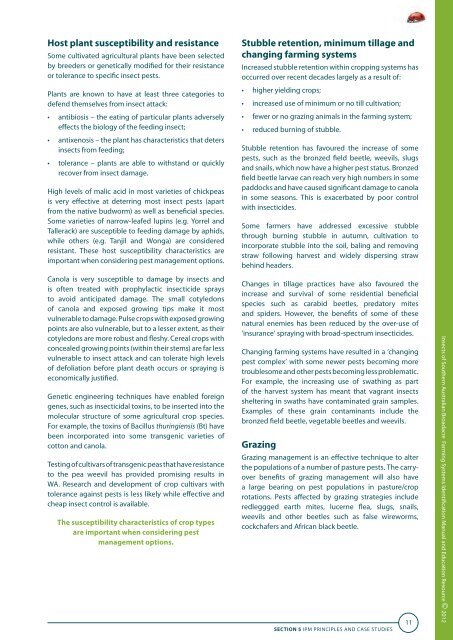Insects of Southern Australian Broadacre Farming Systems - Grains ...
Insects of Southern Australian Broadacre Farming Systems - Grains ...
Insects of Southern Australian Broadacre Farming Systems - Grains ...
Create successful ePaper yourself
Turn your PDF publications into a flip-book with our unique Google optimized e-Paper software.
Host plant susceptibility and resistance<br />
Some cultivated agricultural plants have been selected<br />
by breeders or genetically modified for their resistance<br />
or tolerance to specific insect pests.<br />
Plants are known to have at least three categories to<br />
defend themselves from insect attack:<br />
• antibiosis – the eating <strong>of</strong> particular plants adversely<br />
effects the biology <strong>of</strong> the feeding insect;<br />
• antixenosis – the plant has characteristics that deters<br />
insects from feeding;<br />
• tolerance – plants are able to withstand or quickly<br />
recover from insect damage.<br />
High levels <strong>of</strong> malic acid in most varieties <strong>of</strong> chickpeas<br />
is very effective at deterring most insect pests (apart<br />
from the native budworm) as well as beneficial species.<br />
Some varieties <strong>of</strong> narrow-leafed lupins (e.g. Yorrel and<br />
Tallerack) are susceptible to feeding damage by aphids,<br />
while others (e.g. Tanjil and Wonga) are considered<br />
resistant. These host susceptibility characteristics are<br />
important when considering pest management options.<br />
Canola is very susceptible to damage by insects and<br />
is <strong>of</strong>ten treated with prophylactic insecticide sprays<br />
to avoid anticipated damage. The small cotyledons<br />
<strong>of</strong> canola and exposed growing tips make it most<br />
vulnerable to damage. Pulse crops with exposed growing<br />
points are also vulnerable, but to a lesser extent, as their<br />
cotyledons are more robust and fleshy. Cereal crops with<br />
concealed growing points (within their stems) are far less<br />
vulnerable to insect attack and can tolerate high levels<br />
<strong>of</strong> defoliation before plant death occurs or spraying is<br />
economically justified.<br />
Genetic engineering techniques have enabled foreign<br />
genes, such as insecticidal toxins, to be inserted into the<br />
molecular structure <strong>of</strong> some agricultural crop species.<br />
For example, the toxins <strong>of</strong> Bacillus thuringiensis (Bt) have<br />
been incorporated into some transgenic varieties <strong>of</strong><br />
cotton and canola.<br />
Testing <strong>of</strong> cultivars <strong>of</strong> transgenic peas that have resistance<br />
to the pea weevil has provided promising results in<br />
WA. Research and development <strong>of</strong> crop cultivars with<br />
tolerance against pests is less likely while effective and<br />
cheap insect control is available.<br />
The susceptibility characteristics <strong>of</strong> crop types<br />
are important when considering pest<br />
management options.<br />
Stubble retention, minimum tillage and<br />
changing farming systems<br />
Increased stubble retention within cropping systems has<br />
occurred over recent decades largely as a result <strong>of</strong>:<br />
• higher yielding crops;<br />
• increased use <strong>of</strong> minimum or no till cultivation;<br />
• fewer or no grazing animals in the farming system;<br />
• reduced burning <strong>of</strong> stubble.<br />
Stubble retention has favoured the increase <strong>of</strong> some<br />
pests, such as the bronzed field beetle, weevils, slugs<br />
and snails, which now have a higher pest status. Bronzed<br />
field beetle larvae can reach very high numbers in some<br />
paddocks and have caused significant damage to canola<br />
in some seasons. This is exacerbated by poor control<br />
with insecticides.<br />
Some farmers have addressed excessive stubble<br />
through burning stubble in autumn, cultivation to<br />
incorporate stubble into the soil, baling and removing<br />
straw following harvest and widely dispersing straw<br />
behind headers.<br />
Changes in tillage practices have also favoured the<br />
increase and survival <strong>of</strong> some residential beneficial<br />
species such as carabid beetles, predatory mites<br />
and spiders. However, the benefits <strong>of</strong> some <strong>of</strong> these<br />
natural enemies has been reduced by the over-use <strong>of</strong><br />
‘insurance’ spraying with broad-spectrum insecticides.<br />
Changing farming systems have resulted in a ‘changing<br />
pest complex’ with some newer pests becoming more<br />
troublesome and other pests becoming less problematic.<br />
For example, the increasing use <strong>of</strong> swathing as part<br />
<strong>of</strong> the harvest system has meant that vagrant insects<br />
sheltering in swaths have contaminated grain samples.<br />
Examples <strong>of</strong> these grain contaminants include the<br />
bronzed field beetle, vegetable beetles and weevils.<br />
Grazing<br />
Grazing management is an effective technique to alter<br />
the populations <strong>of</strong> a number <strong>of</strong> pasture pests. The carryover<br />
benefits <strong>of</strong> grazing management will also have<br />
a large bearing on pest populations in pasture/crop<br />
rotations. Pests affected by grazing strategies include<br />
redleggged earth mites, lucerne flea, slugs, snails,<br />
weevils and other beetles such as false wireworms,<br />
cockchafers and African black beetle.<br />
SECTION 5 IPM Principles and Case Studies<br />
11<br />
<strong>Insects</strong> <strong>of</strong> <strong>Southern</strong> <strong>Australian</strong> <strong>Broadacre</strong> <strong>Farming</strong> <strong>Systems</strong> Identification Manual and Education Resource © 2012

















